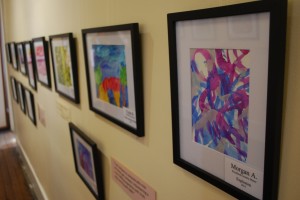Miami Art Program Connects With Elderly
The first thing you notice about the artwork is the variety. One piece features a mottled blend of pink, cream, and orange watercolor paints, with an overlay of gold glitter. Another is composed of a black background, with a blue-painted leaf and an abstract spattering of red and orange paint at the leaf’s tips. The pieces are beautiful, but their creation is for a purpose that goes beyond aesthetic appeal.
The idea for Opening Minds Through Art, an art program for senior citizens with dementia, came to Elizabeth Lokon while she was working on her Ph.D in Gerontology. “She noticed that many of the activities in long-term were not appropriate for the age or ability levels of people with dementia, and OMA became her thesis,” said Eleni Balli, a student leader of the program, which is now used by eleven elder care facilities in the Southwest Ohio area. “She wanted to give people with dementia choices they don’t get in their everyday lives and promote the autonomy and dignity of people with dementia.”
The methodology of the program follows suit. OMA art projects are abstract, so success is “almost guaranteed”, according to Lokon. Each project is evaluated by volunteers to ensure that the activity is fun, appropriate for all ability levels, appealing to both genders, offers enough choices, and is visually appealing. Each volunteer consequently finds their own creative path. “You have no idea what this experience did for me,” one volunteer said. “It made me feel like a real artist.”
If a participant isn’t interested in the project, other options are always available. Some experience a change of heart. “Sometimes, [my elder] doesn’t want to do it at the beginning, but once we get to the end she always talks about how much fun she’s had,” commented one student volunteer. “It’s really cool to see the difference from start to finish.”
Unique to the program is its strict volunteer code; one student volunteer is matched up with each and every participant to assist them in project completion. However, the relationship becomes about more than paint and paper; the volunteer becomes both an assistant and a guide for the participant, skillfully balancing aid when it is necessary with autonomy for the elder.
“What kinds of things do you see here?” asks one volunteer, gazing upon the series of ink blots that her partner has placed on a page. In response, her partner curls her fingers to resemble claws. An animal, perhaps? Both laugh and continue to work through the project together.
The idea behind this close personal contact is that a relationship has been established between each elder and volunteer, and each generation learns from the other. Emily, a student volunteer, reported that she has benefited and learned a lot from her friendship with her elder. “It’s really cool to see how they put their thoughts and memories that they can retrieve into their artwork.” Another volunteer spoke of her grandmother, who had had dementia herself. “I understand more about what she was going through, which I didn’t really understand before,” she said.
Research by the Scripps Gerontology Center at Miami has confirmed the benefit of the program for students. A study by Lokon and two colleagues published in the Journal of Intergenerational Relationships analyzed 300 journals written by student volunteers, and found that the program enriched their academic learning, made them feel they had been rewarded for having made a positive contribution, and improved their attitudes toward people with dementia. Current research focuses on the impact of OMA art projects upon elder well-being. Though data from that study is not concrete yet, Philip Sauer, doctoral associate at the Scripps Center, reports that he is optimistic about what he has seen so far. “Overall, we are delighted with the preliminary data we have found,” he said.
Ability, not disability. Creativity, not confinement. In a world where we are often defined by what we are unable to do, Elizabeth Lokon and her colleagues have found a way for senior citizens with a debilitating mental disease to freely express themselves, while at the same time forging rewarding relationships between them and student volunteers. What’s next for the program? Only time will tell. But one thing is for sure – OMA is making a huge impact, and it is doing so right now.



